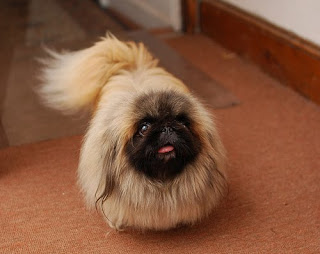


The Shih Tzu (pronounced /ˈʃiːtsuː/ SHEE-tsoo, from Mandarin [ʂɨ́tsɨ]) is a breed of small tibet of very ancient dog type, with long silky fur. The breed originated in China. The name is both singular and plural.
Appearance
A small dog with a short muzzle and large deep dark eyes, with a soft long, double coat, the Shih Tzu stands no more than 26.7 cm (10 1/2 in.) at the withers and with an ideal weight of 4.5 to 7.3 kg (10 to 16 lbs). Drop ears are covered with long fur, and the heavily furred tail is carried curled over the back. The coat may be of any color, although a blaze of white on the forehead and tail-tip is frequently seen. The Shih Tzu is slightly longer than tall, and dogs ideally should carry themselves "with distinctly arrogant carriage".
Temperament
The Shih Tzu is a friendly lap dog that at one time was bred to be a companion dog for Chinese royalty. Some say living in the imperial palace gave the Shih Tzu an arrogant quality, although they also display qualities of devotion and adaptability.They are not afraid to stand up for themselves. They tend to be sweet, playful, and trusting as well. It ranks 70th in Stanley Coren's The Intelligence of Dogs, considered one of the lowest degree of working/obedience intelligence (trainability).
Coat Colors
The Shih Tzu comes in a range of colors that include various shades of gold and white and red and white. Other colors include black mask gold, solid red, black and white, solid black, solid liver, liver and white, blue and white, brindle and white and silver and white.[14] Though not as common there are also solid blue Shih Tzu. An interesting point (and often a point of confusion) is that while the coat color of those with black pigmented skin (nose, lips, pads, also referred to as "leather") is determined by the color of the coat itself; the coat color on dogs with either liver or blue pigment is categorized by the color of the pigment. Thus a parti colored (white and another shade) Shih Tzu with blue pigment is a "blue and white" regardless of the tint of the hair which might very well appear similar to a gold and white or other colors. The same principle applies to solid blue, liver and liver and white.
Size issues
There is no such thing as a "teacup" Shih Tzu nor a "toy sized" Shih Tzu Imperial. Shih Tzu is a term used by breeders to sell Shih Tzu that are below healthy standard size.These tiny dogs, often less than 50% of the recommended minimum size, are prone to serious health problems and may not live a full life span. Many are created by breeding the runt of one litter with the runt of another litter.
MY OWN OPINION:
CUTE AND A BIT NOISY! HAHAHA! :) SHIH TZU OWNERS LOVES TO DRESS THEM!
LOVES







